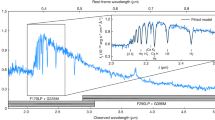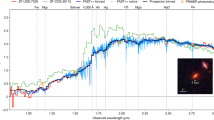Abstract
Unlike spiral galaxies such as the Milky Way, the majority of the stars in massive elliptical galaxies were formed in a short period early in the history of the Universe. The duration of this formation period can be measured using the ratio of magnesium to iron abundance ([Mg/Fe]) in spectra1,2,3,4, which reflects the relative enrichment by core-collapse and type Ia supernovae. For local galaxies, [Mg/Fe] probes the combined formation history of all stars currently in the galaxy, including younger and metal-poor stars that were added during late-time mergers5. Therefore, to directly constrain the initial star-formation period, we must study galaxies at earlier epochs. The most distant galaxy for which [Mg/Fe] had previously been measured6 is at a redshift of z ≈ 1.4, with [Mg/Fe] =  . A slightly earlier epoch (z ≈ 1.6) was probed by combining the spectra of 24 massive quiescent galaxies, yielding an average [Mg/Fe] = 0.31 ± 0.12 (ref. 7). However, the relatively low signal-to-noise ratio of the data and the use of index analysis techniques for both of these studies resulted in measurement errors that are too large to allow us to form strong conclusions. Deeper spectra at even earlier epochs in combination with analysis techniques based on full spectral fitting are required to precisely measure the abundance pattern shortly after the major star-forming phase (z > 2). Here we report a measurement of [Mg/Fe] for a massive quiescent galaxy at a redshift of z = 2.1, when the Universe was three billion years old. With [Mg/Fe] = 0.59 ± 0.11, this galaxy is the most Mg-enhanced massive galaxy found so far, having twice the Mg enhancement of similar-mass galaxies today. The abundance pattern of the galaxy is consistent with enrichment exclusively by core-collapse supernovae and with a star-formation timescale of 0.1 to 0.5 billion years—characteristics that are similar to population II stars in the Milky Way. With an average past star-formation rate of 600 to 3,000 solar masses per year, this galaxy was among the most vigorous star-forming galaxies in the Universe.
. A slightly earlier epoch (z ≈ 1.6) was probed by combining the spectra of 24 massive quiescent galaxies, yielding an average [Mg/Fe] = 0.31 ± 0.12 (ref. 7). However, the relatively low signal-to-noise ratio of the data and the use of index analysis techniques for both of these studies resulted in measurement errors that are too large to allow us to form strong conclusions. Deeper spectra at even earlier epochs in combination with analysis techniques based on full spectral fitting are required to precisely measure the abundance pattern shortly after the major star-forming phase (z > 2). Here we report a measurement of [Mg/Fe] for a massive quiescent galaxy at a redshift of z = 2.1, when the Universe was three billion years old. With [Mg/Fe] = 0.59 ± 0.11, this galaxy is the most Mg-enhanced massive galaxy found so far, having twice the Mg enhancement of similar-mass galaxies today. The abundance pattern of the galaxy is consistent with enrichment exclusively by core-collapse supernovae and with a star-formation timescale of 0.1 to 0.5 billion years—characteristics that are similar to population II stars in the Milky Way. With an average past star-formation rate of 600 to 3,000 solar masses per year, this galaxy was among the most vigorous star-forming galaxies in the Universe.
This is a preview of subscription content, access via your institution
Access options
Subscribe to this journal
Receive 51 print issues and online access
$199.00 per year
only $3.90 per issue
Buy this article
- Purchase on Springer Link
- Instant access to full article PDF
Prices may be subject to local taxes which are calculated during checkout



Similar content being viewed by others
References
Matteucci, F. Abundance ratios in ellipticals and galaxy formation. Astron. Astrophys. 288, 57–64 (1994)
Trager, S. C., Faber, S. M., Worthey, G. & González, J. J. The stellar population histories of early-type galaxies. II. Controlling parameters of the stellar populations. Astron. J. 120, 165–188 (2000)
Thomas, D., Maraston, C., Bender, R. & Mendes de Oliveira, C. The epochs of early-type galaxy formation as a function of environment. Astrophys. J. 621, 673–694 (2005)
Conroy, C., Graves, G. J. & van Dokkum, P. G. Early-type galaxy archeology: ages, abundance ratios, and effective temperatures from full-spectrum fitting. Astrophys. J. 780, 33 (2014)
van Dokkum, P. G. et al. The growth of massive galaxies since z = 2. Astrophys. J. 709, 1018–1041 (2010)
Lonoce, I. et al. Old age and supersolar metallicity in a massive z ~ 1.4 early-type galaxy from VLT/X-Shooter spectroscopy. Mon. Not. R. Astron. Soc. 454, 3912–3919 (2015)
Onodera, M. et al. The ages, metallicities, and element abundance ratios of massive quenched galaxies at z ≃ 1.6. Astrophys. J. 808, 161 (2015)
McLean, I. S. et al. MOSFIRE, the multi-object spectrometer for infra-red exploration at the Keck Observatory. Proc. SPIE 8446, 84460J (2012)
Belli, S., Newman, A. B., Ellis, R. S. & Konidaris, N. P. MOSFIRE absorption line spectroscopy of z > 2 quiescent galaxies: probing a period of rapid size growth. Astrophys. J. 788, L29 (2014)
Kriek, M. et al. The MOSFIRE Deep Evolution Field (MOSDEF) survey: rest-frame optical spectroscopy for ~1500 H-selected galaxies at 1.37 ≤ z ≤ 3.8. Astrophys. J. Suppl. Ser. 218, 15 (2015)
Skelton, R. E. et al. 3D-HST WFC3-selected photometric catalogs in the five CANDELS/3D-HST fields: photometry, photometric redshifts, and stellar masses. Astrophys. J. Suppl. Ser. 214, 24 (2014)
Momcheva, I. G. et al. The 3D-HST survey: Hubble Space Telescope WFC3/G141 grism spectra, redshifts, and emission line measurements for ~100,000 galaxies. Preprint at https://arxiv.org/abs/1510.02106 (2015)
van de Sande, J. et al. Stellar kinematics of z ~ 2 galaxies and the inside-out growth of quiescent galaxies. Astrophys. J. 771, 85 (2013)
Conroy, C. & van Dokkum, P. Counting low-mass stars in integrated light. Astrophys. J. 747, 69 (2012)
Choi, J. et al. The assembly histories of quiescent galaxies since z = 0.7 from absorption line spectroscopy. Astrophys. J. 792, 95 (2014)
Kroupa, P. On the variation of the initial mass function. Mon. Not. R. Astron. Soc. 322, 231–246 (2001)
Conroy, C. & van Dokkum, P. G. The stellar initial mass function in early-type galaxies from absorption line spectroscopy. II. Results. Astrophys. J. 760, 71 (2012)
Salpeter, E. E. The luminosity function and stellar evolution. Astrophys. J. 121, 161–167 (1955)
Kobayashi, C., Umeda, H., Nomoto, K., Tominaga, N. & Ohkubo, T. Galactic chemical evolution: carbon through zinc. Astrophys. J. 653, 1145–1171 (2006)
Nomoto, K., Thielemann, F.-K. & Yokoi, K. Accreting white dwarf models of type I supernovae. III. Carbon deflagration supernovae. Astrophys. J. 286, 644–658 (1984)
Maoz, D., Mannucci, F. & Brandt, T. D. The delay-time distribution of type Ia supernovae from Sloan II. Mon. Not. R. Astron. Soc. 426, 3282–3294 (2012)
Kobayashi, C. & Nomoto, K. The role of type Ia supernovae in chemical evolution. I. Lifetime of type Ia supernovae and metallicity effect. Astrophys. J. 707, 1466–1484 (2009)
Thielemann, F.-K., Nomoto, K. & Hashimoto, M.-A. Core-collapse supernovae and their ejecta. Astrophys. J. 460, 408–436 (1996)
Woosley, S. E. & Weaver, T. A. The evolution and explosion of massive stars. II. Explosive hydrodynamics and nucleosynthesis. Astrophys. J. Suppl. Ser. 101, 181–235 (1995)
Fulbright, J. P., McWilliam, A. & Rich, R. M. Abundances of Baade’s window giants from Keck HIRES spectra. II. The alpha and light odd elements. Astrophys. J. 661, 1152–1179 (2007)
Riechers, D. A. et al. A dust-obscured massive maximum-starburst galaxy at a redshift of 6.34. Nature 496, 329–333 (2013)
Worthey, G., Faber, S. M., Gonzalez, J. J. & Burstein, D. Old stellar populations. V. Absorption feature indices for the complete LICK/IDS sample of stars. Astrophys. J. Suppl. Ser. 94, 687–722 (1994)
Thomas, D., Maraston, C. & Bender, R. Stellar population models of Lick indices with variable element abundance ratios. Mon. Not. R. Astron. Soc. 339, 897–911 (2003)
van Dokkum, P. G. et al. Confirmation of the remarkable compactness of massive quiescent galaxies at z ~ 2.3: early-type galaxies did not form in a simple monolithic collapse. Astrophys. J. 677, L5–L8 (2008)
Naab, T., Johansson, P. H. & Ostriker, J. P. Minor mergers and the size evolution of elliptical galaxies. Astrophys. J. 699, L178–L182 (2009)
Conroy, C., Gunn, J. E. & White, M. The propagation of uncertainties in stellar population synthesis modeling. I. The relevance of uncertain aspects of stellar evolution and the initial mass function to the derived physical properties of galaxies. Astrophys. J. 699, 486–506 (2009)
Conroy, C. & Gunn, J. E. The propagation of uncertainties in stellar population synthesis modeling. III. Model calibration, comparison, and evaluation. Astrophys. J. 712, 833–857 (2010)
Kriek, M. & Conroy, C. The dust attenuation law in distant galaxies: evidence for variation with spectral type. Astrophys. J. 775, L16 (2013)
Chabrier, G. Galactic stellar and substellar initial mass function. Publ. Astron. Soc. Pacif. 115, 763–795 (2003)
Bruzual, G. & Charlot, S. Stellar population synthesis at the resolution of 2003. Mon. Not. R. Astron. Soc. 344, 1000–1028 (2003)
Maraston, C. Evolutionary population synthesis: models, analysis of the ingredients and application to high-z galaxies. Mon. Not. R. Astron. Soc. 362, 799–825 (2005)
Cardelli, J. A., Clayton, G. C. & Mathis, J. S. The relationship between infrared, optical, and ultraviolet extinction. Astrophys. J. 345, 245–256 (1989)
Calzetti, D. et al. The dust content and opacity of actively star-forming galaxies. Astrophys. J. 533, 682–695 (2000)
Foreman-Mackey, D., Hogg, D. W., Lang, D. & Goodman, J. emcee: the MCMC hammer. Publ. Astron. Soc. Pacif. 125, 306–312 (2013)
Kriek, M. et al. An ultra-deep near-infrared spectrum of a compact quiescent galaxy at z = 2.2. Astrophys. J. 700, 221–231 (2009)
Acknowledgements
M.K. acknowledges discussions with J. Greene and E. Quataert. The data presented in this paper were obtained at the W. M. Keck Observatory, which is operated as a scientific partnership between the California Institute of Technology, the University of California and the National Aeronautics and Space Administration. The Observatory was made possible by the financial support of the W. M. Keck Foundation. We acknowledge the cultural role that the summit of Mauna Kea has within the indigenous Hawaiian community. We acknowledge support from NSF AAG collaborative grants AST-1312780, 1312547, 1312764 and 1313171 and archival grant AR-13907, provided by NASA through a grant from the Space Telescope Science Institute. C.C. acknowledges support from NASA grant NNX13AI46G, NSF grant AST-1313280 and the Packard Foundation.
Author information
Authors and Affiliations
Contributions
M.K., P.G.v.D. and C.C. wrote the primary Keck proposal. M.K. and C.C. led the interpretation. M.K. wrote the reduction pipeline, reduced the data, determined the stellar mass, measured the Lick indices and wrote the text. C.C. developed the SPS model, fitted the spectrum and derived the chemical evolution model. M.K., P.G.v.D., J.C., F.v.d.V. and N.A.R. did the observations. All authors contributed to the analysis and interpretation.
Corresponding author
Ethics declarations
Competing interests
The authors declare no competing financial interests.
Additional information
Reviewer Information
Nature thanks T. C. Beers, C. Kobayashi and C. Maraston for their contribution to the peer review of this work.
Source data
Rights and permissions
About this article
Cite this article
Kriek, M., Conroy, C., van Dokkum, P. et al. A massive, quiescent, population II galaxy at a redshift of 2.1. Nature 540, 248–251 (2016). https://doi.org/10.1038/nature20570
Received:
Accepted:
Published:
Issue Date:
DOI: https://doi.org/10.1038/nature20570
This article is cited by
-
A population of faint, old, and massive quiescent galaxies at \(3<z<4\) revealed by JWST NIRSpec Spectroscopy
Scientific Reports (2024)
-
A massive quiescent galaxy at redshift 4.658
Nature (2023)
-
The $11-billion Webb telescope aims to probe the early Universe
Nature (2021)
-
De re metallica: the cosmic chemical evolution of galaxies
The Astronomy and Astrophysics Review (2019)
-
Elemental abundances across cosmic time
Nature (2016)
Comments
By submitting a comment you agree to abide by our Terms and Community Guidelines. If you find something abusive or that does not comply with our terms or guidelines please flag it as inappropriate.



